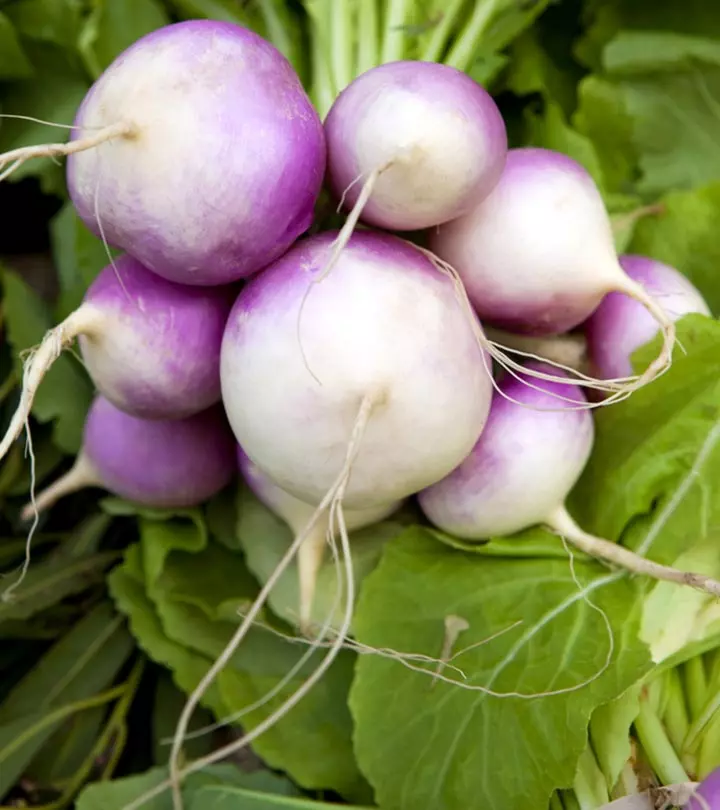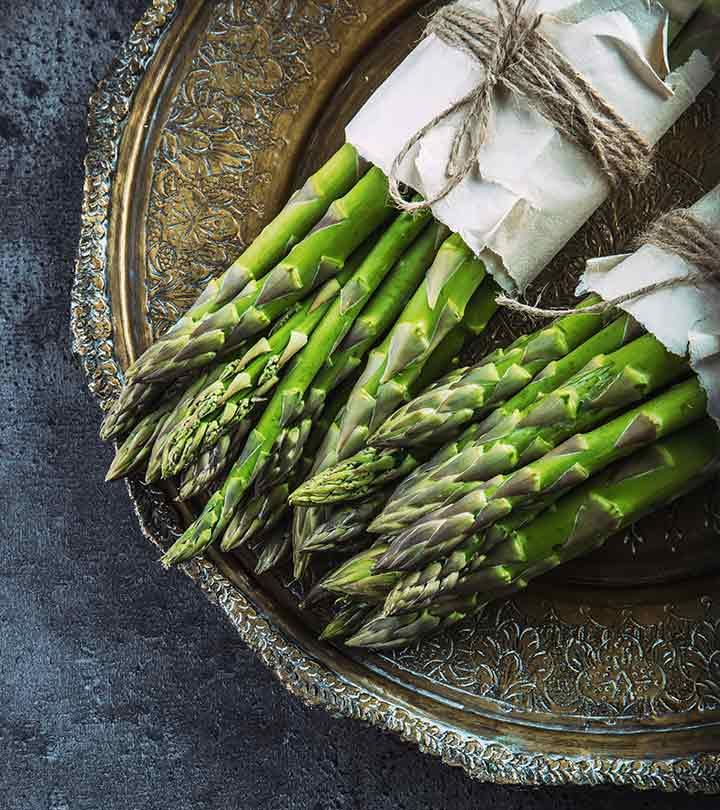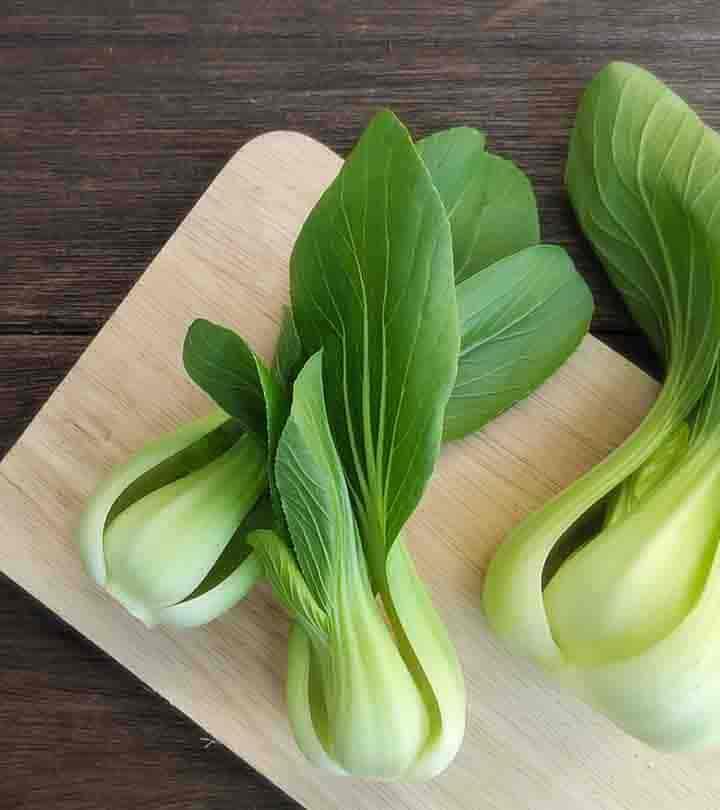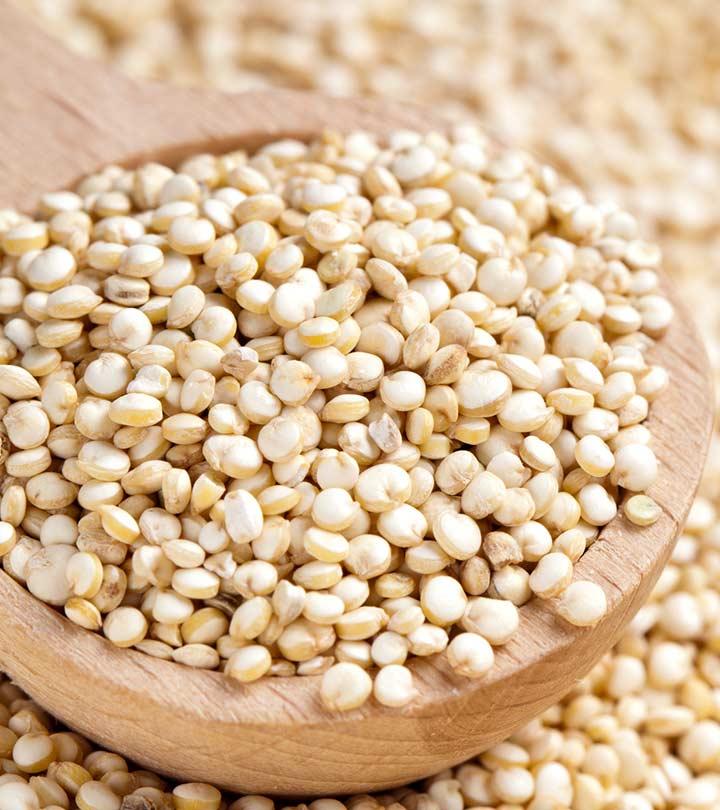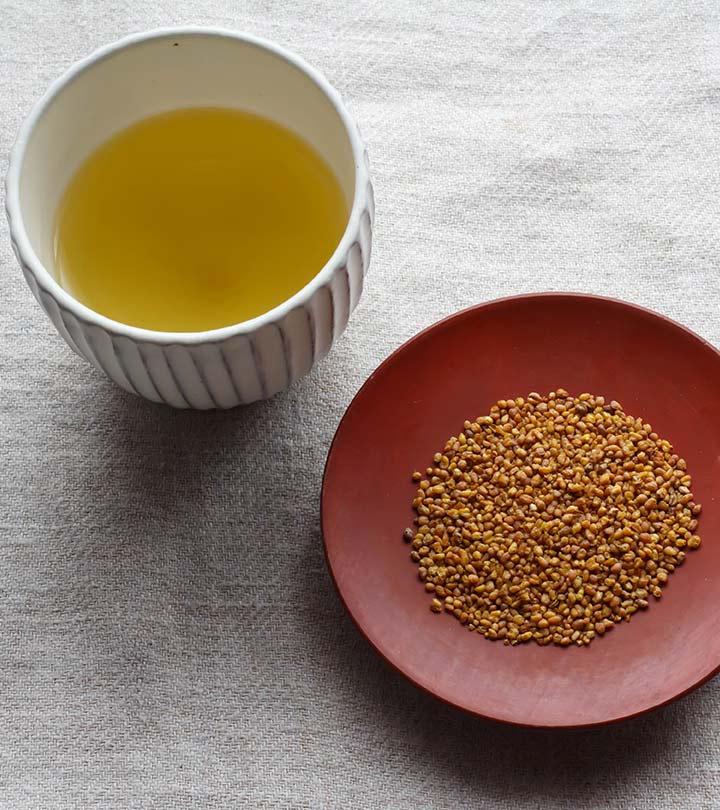12 Health Benefits Of Pistachio & Effects If You Eat Too Many
From supporting weight loss to promoting heart health, pistachios improve your overall health.

Image: Shutterstock
Several benefits of pistachio nuts make them a wonderful addition to any diet. Pistachios (Pistacia vera)contain potent antioxidants, dietary fibers, proteins, vitamins, and healthy fats. These low-fat nuts may enhance gut health, help control blood glucose levels, and aid in weight management.
This article discusses the benefits of pistachio nuts, their nutritional profile, how to consume them, and any potential side effects. So let’s take a look at what pistachios are good for.
 Know Your Ingredient: Pistachio
Know Your Ingredient: PistachioWhat Is It?
An edible nut from the pistachio tree with a rich nutritional profile.
What Are Its Benefits?
May aid weight loss, enhance gut health, improve heart health, and help in diabetes treatment.
Who Can Consume It?
All except those who are allergic to tree nuts.
How Often?
A daily serving of pistachios of about 1 ounce (49 kernels) is recommended.
Caution
People who are allergic to tree nuts should avoid eating them. Also, overconsumption can lead to unwanted weight gain.
In This Article
How Are Pistachios Good For You?
A 28-gram serving of pistachios contains good amounts of fiber, protein, potassium, zinc, phosphorus, vitamin B6, and manganese (1). They have a rich and nutty taste.
Pistachios contain the highest amount of antioxidants among nuts. All of these benefit human health in various ways. We will explore them in the following section.
 Trivia
TriviaWhat Are The Benefits Of Pistachios?
1. May Aid Weight Loss
Pistachios contain fiber. Studies show that fiber intake may promote satiety and, in turn, help with weight loss (2). Another nutrient with similar qualities is protein, which can reduce hunger pangs (3).
Pistachios are dried fruits. Studies have demonstrated that consuming them can keep inches off your waist over time (4). The nuts also have beneficial effects on triglycerides. They can be consumed as a healthy snack to lose weight, without having to worry about their fat content (5).
According to a study, the lipid content in pistachios are not fully absorbed by the body. This reduces the body’s fat content (6).
In another study, people who ate in-shell pistachios consumed less calories than those who ate shelled pistachios (7).
2. May Enhance Gut Health
The fiber in pistachios aids digestion and prevents constipation (8).
The gut bacteria ferment this fiber and produce short-chain fatty acids, which have several benefits. They help in colon cancer prevention and improve overall digestive health. Butyrate is one such beneficial short-chain fatty acid, and its consumption increases the number of good bacteria in the gut (9).
3. May Improve Heart Health
Research has shown that pistachios may help prevent heart ailments by increasing the levels of heart-healthy fats. They can also lower bad cholesterol and reduce the risk of coronary heart disease (10).
Pistachios lower the levels of lipoproteins, which are a risk factor for heart disease (11). Diets containing these nuts were also found to lower blood pressure levels (12). The nuts contain arginine, an amino acid. Arginine was also found to lower blood pressure (13).
4. May Aid Diabetes Treatment
Glucose levels were found to be lower with pistachio consumption (14). The nuts also increase the levels of peptide 1, a hormone that regulates glucose levels in those with diabetes (15). Thus, it helps in blood sugar control.
An Iranian study also states that the dietary intake of pistachio nuts can have positive effects on glycemic control, blood pressure, inflammation, and obesity in individuals with diabetes (14).
Did You Know?
Pistachio is known as the Smiling Nut in Iran and the Happy Nut in China.
5. May Be Beneficial During Pregnancy And Breastfeeding
Pistachios offer a healthy dose of several nutrients that are important during pregnancy. Studies show that diets including these nuts can be of help during this period (16).
Pistachios may also benefit breastfeeding mothers due to their nutritions provided by it. They are also easy to be included in the diet. Busy nursing mothers can simply snack on pistachios as they are.
6. May Combat Inflammation
The bioactives present in pistachios may help fight inflammation. These anti-inflammatory properties can be put to therapeutic use (17). Pistachios are also rich in monounsaturated fats. Some believe these may also help combat inflammation, though more research is warranted in this aspect (18).
7. May Improve Vision Health
Pistachios are a rich source of lutein and zeaxanthin (19). Lutein and zeaxanthin are found in the human retina. Consuming enough of these antioxidants prevents vision issues like age-related macular degenerationi An eye disorder where a part of the retina is affected, impairing central vision and making it difficult to perform daily activities. and cataractsi The gradual development of blurry vision as the eye's naturally clear lens becomes clouded, interfering with daily activities. (20).
Pistachios are also rich in zinc (1). A deficiency of the mineral has been linked to poor night vision (21).
The healthy fatty acids in pistachios may also contribute to eye health. However, we need more research to substantiate this.
8. May Boost Cognitive Function
Pistachios, like most nuts, are good sources of vitamin E (1). In rat studies, the nutrient was found to decrease the risk of peripheral neurotoxicityi Damage to peripheral nerves (present away from the brain and spinal cord) resulting in weakness, numbness, and pain in the extremities. (22).
Ripe pistachio shells were found to alleviate anxiety in rats (23). The nuts may also enhance cognitive performance, learning, information retention, and rapid eye movementi A stage of sleep where the eyes move quickly and randomly, characterized by the occurrence of more vivid dreams. during sleep. However, sufficient data is lacking in this regard.
Some anecdotal evidence suggests that pistachio nut oil may also fight brain inflammation and preserve the essential fatty acids in the brain.
Pistachios may also have a role to play in protecting brain function from the potential disruptions caused by anticancer drugs (24).
Did You Know?
Pistachios are the original prehistoric snacks. In fact, they are one of the only two nuts mentioned in the Bible.
10. May Enhance Sexual Health
Anecdotal evidence suggests that pistachios may boost fertility. However, we need more research in this regard.
Studies show that pistachios can act as an aphrodisiac. Eating a handful of the nuts every day for three weeks was found to improve sex drive in men. The arginine, phytosterol, and antioxidants in the nuts have shown to help treat erectile dysfunction (25).
11. May Increase Estrogen Levels
Pistachios have the highest amount of phytoestrogens amongst nuts (26). They may increase estrogen levels and contribute to a regulated menstrual cycle and secondary sex characteristics.
12. May Slow Down Premature Aging
Pistachios contain vitamin E. The vitamin prevents chronic UV photoaging of the skin (27). The nuts also contain copper. The nutrient aids the production of elastin, which prevents the formation of wrinkles and treats sagging skin (28). Thus, it can be said that pistachios ultimately promote skin health.
In a study, mice treated with vitamin E showed fewer signs of UV-induced skin damage (29).
These are the health benefits of pistachios. While we saw some of the nutrients the nuts contain, there are other important compounds that are responsible for the benefits. In the following section, we will look at the nutritional profile of pistachios.
What Is The Nutritional Profile Of Pistachios?
| PRINCIPLE | NUTRIENT VALUE | PERCENTAGE OF RDA |
|---|---|---|
| Energy | 557 Kcal | 29% |
| Carbohydrates | 27.97 g | 21.5% |
| Protein | 20.60 g | 37% |
| Total Fat | 44.44 g | 148% |
| Cholesterol | 0 mg | 0% |
| Dietary Fiber | 10.3g | 27% |
| VITAMINS | ||
| Folates | 51 µg | 13% |
| Niacin | 1.3 mg | 8% |
| Pantothenic acid | 0.520 mg | 10% |
| Pyridoxine | 1.7 mg | 131% |
| Riboflavin | 0.160 mg | 12% |
| Thiamin | 0.870 mg | 72.5% |
| Vitamin A | 553 IU | 18% |
| Vitamin C | 5 mg | 8% |
| Vitamin E-? | 22.60 mg | 150% |
| ELECTROLYTES | ||
| Sodium | 1 mg | 0% |
| Potassium | 1025 mg | 22% |
| MINERALS | ||
| Calcium | 107 mg | 11% |
| Copper | 1.3 mg | 144% |
| Iron | 4.15 mg | 52% |
| Magnesium | 121 mg | 30% |
| Manganese | 1.2 mg | 52% |
| Phosphorus | 376 mg | 54% |
| Selenium | 7 µg | 13% |
| Zinc | 2.20 mg | 20% |
| PHYTO-NUTRIENTS | ||
| Carotene-ß | 332 µg | — |
| Crypto-xanthin-ß | 0 µg | — |
| Lutein-zeaxanthin | 1160 µg | — |
*Values sourced from USDA, nuts, pistachio nuts, raw
As you have seen, pistachios have an exceptional nutritional profile. Including them in your diet is fairly easy. The following two recipes are a good place to start.
Pistachio Recipes
1. Pistachio Crusted Salmon
Ingredients
- 4 salmon filets
- ½ cup of pistachios, crushed
- 2 tablespoons of olive oil
- 1 tablespoon of Dijon mustard
- Salt and pepper, to taste
How To Prepare
- Preheat the oven to 375°F (190°C).
- Mix pistachios, olive oil, Dijon mustard, salt, and pepper in a bowl.
- Lay salmon filets on a parchment-lined baking sheet.
- Coat the salmon with the mixture.
- Bake for 12 to 15 minutes and serve hot.
2. Pistachio And Honey Yogurt Parfait
Ingredients
- 1 cup of Greek yogurt
- 2 tablespoons of honey
- ¼ cup of pistachios, crushed
- ½ cup of fresh berries (strawberries, blueberries, or raspberries)
How To Prepare
- Make a layer of Greek yogurt in a bowl.
- Drizzle honey over it.
- Add a layer of berries.
- Sprinkle with the crushed pistachios.
- Drizzle the remaining honey on top and enjoy.
Though pistachios can be healthy and are replete with essential nutrients, it is important not to consume too many of them.
What Happens When You Eat Too Many Pistachios?
Excess consumption of pistachios may lead to abdominal pain, constipation, and diarrhea. This could be due to its fibre content. Some also believe the nuts may lead to kidney stones in susceptible individuals. However, these effects are backed only by anecdotal evidence.
If you are taking roasted pistachios in excess, you may experience high blood pressure levels. This is because some forms of roasted pistachios are high in sodium.
 Fun Fact
Fun FactInfographic: 4 Reasons Pistachios Are Good For Your Overall Health
Pistachios are green edible seeds of the pistachio tree. They are crunchy, enclosed in a shell, and taste sweet. They are good sources of fiber, antioxidants, vitamins, healthy fats, and protein and offer important health benefits. In the infographic below, we have listed a few of those. Check it out!

Illustration: StyleCraze Design Team
Pistachios are healthy nuts with several essential nutrients. They contain healthy fats, antioxidants, protein, and fiber that help improve your overall health. The benefits of pistachios are numerous, and you can easily include them in your diet. Intake of pistachios may aid in weight loss, enhance gut health, improve heart health, regulate blood glucose levels, and fight inflammation. Though there are no recorded side effects of pistachios, taking them in moderation is advised. Should you experience any adverse reactions, stop their intake and consult your doctor immediately.
Frequently Asked Questions
How to eat pistachios?
You can crack open the shell and eat the nut. Or you can also first suck the salty exterior of the shell before opening it up.
How long do pistachios last?
Pistachios can last for about 3 months if stored in the refrigerator. Place the nuts in an airtight container in the refrigerator.
Why are pistachios expensive?
The pistachio trees have two requirements to grow – cool winters, and long hot summers with low humidity. These limit the areas they can be grown in, making the nuts quite expensive.
How to tell if pistachios are bad?
Usually, pistachios that have gone bad taste extremely sour.
How many pistachios should I have per day?
You can have 1.5 ounces to 3 ounces per day, which translates to about a handful of the nuts.
Are pistachio shells poisonous?
Pistachio shells are not poisonous. But they can be too hard to eat. Consuming them as they are may cause digestive issues.
Are roasted pistachio nuts good for you?
Yes, roasted pistachio nuts are good for you. Roasted nuts have less fat content when compared to other nuts (19).
Is it safe to eat raw pistachios?
Yes, eating raw pistachios is safe. One ounce of raw pistachios contains 159 calories, 6 grams of protein, 3 grams of fiber, and 8 grams of carbohydrates (1).
Do pistachios help you lose belly fat?
There is no research to support this. Pistachios contain fiber, which may promote a feeling of fullness. This particular attribute, in addition to regular exercise and healthy lifestyle habits, may help with weight loss and belly fat.
Can pistachios boost immunity?
Research is limited in this aspect. Pistachios contain zinc, which may boost immunity. However, the extent to which the nuts can boost the immune system is not known.
What is the best time to eat pistachios?
Evening is the best time to eat pistachios. It is said that these nuts boost stamina and immunity after a long day at work and improve sleep quality due to the presence of melatonin (30).
Why are pistachios good before bed?
Pistachios contain vitamin B6 and magnesium, which have been found to improve sleep quality (1), (31), (32). That is why the intake of pistachios is good before bed.
Which are better for you – almonds or pistachios?
Both nuts are free of cholesterol and sodium. But, pistachios contain more vitamins A and C than almonds (1), (33).
Key Takeaways
- Consuming a few pistachios daily can improve your gut bacteria. Healthy gut microflora can prevent colon cancer.
- Monounsaturated fats in pistachios can help reduce inflammation in your body.
- Eating them frequently can also prevent macular degeneration in your old age owing to their antioxidant content.
- However, eating too many pistachios can give you stomach aches and diarrhea.

Image: Stable Diffusion/StyleCraze Design Team
References
Articles on StyleCraze are backed by verified information from peer-reviewed and academic research papers, reputed organizations, research institutions, and medical associations to ensure accuracy and relevance. Read our editorial policy to learn more.
- “FoodData Central Search Results.” FoodData Central.
fdc.nal.usda.gov/fdc-app.html#/food-details/170184/nutrients - Slavin, Joanne L. “Dietary fiber and body weight.” Nutrition (Burbank, Los Angeles County, Calif.) vol. 21,3 (2005): 411-8.
https://www.ncbi.nlm.nih.gov/pubmed/15797686 - Halton, Thomas L, and Frank B Hu. “The Effects of High Protein Diets on Thermogenesis, Satiety and Weight Loss: a Critical Review.” Journal of the American College of Nutrition.
https://www.ncbi.nlm.nih.gov/pubmed/15466943 - Carughi, Arianna, et al. “Pairing Nuts and Dried Fruit for Cardiometabolic Health.” Nutrition Journal.
https://www.ncbi.nlm.nih.gov/pmc/articles/PMC4779204/ - Li, Zhaoping, et al. “Pistachio Nuts Reduce Triglycerides and Body Weight by Comparison to Refined Carbohydrate Snack in Obese Subjects on a 12-Week Weight Loss Program.” Journal of the American College of Nutrition.
https://www.ncbi.nlm.nih.gov/pubmed/20833992 - Baer, David J, et al. “Measured Energy Value of Pistachios in the Human Diet.” The British Journal of Nutrition.
https://www.ncbi.nlm.nih.gov/pubmed/21733319 - Honselman, Carla S, et al. “In-Shell Pistachio Nuts Reduce Caloric Intake Compared to Shelled Nuts.” Appetite.
https://www.ncbi.nlm.nih.gov/pubmed/21645565 - Wong, Julia M W, et al. “Colonic Health: Fermentation and Short Chain Fatty Acids.” Journal of Clinical Gastroenterology.
https://www.ncbi.nlm.nih.gov/pubmed/16633129 - Ukhanova, Maria, et al. “Effects of Almond and Pistachio Consumption on Gut Microbiota Composition in a Randomised Cross-over Human Feeding Study.” The British Journal of Nutrition.
https://www.ncbi.nlm.nih.gov/pubmed/24642201 - Gebauer, Sarah K et al. “Effects of pistachios on cardiovascular disease risk factors and potential mechanisms of action: a dose-response study.” The American journal of clinical nutritionvol. 88,3 (2008): 651-9.
https://pubmed.ncbi.nlm.nih.gov/18779280 - Edwards, K et al. “Effect of pistachio nuts on serum lipid levels in patients with moderate hypercholesterolemia.” Journal of the American College of Nutritionvol. 18,3 (1999): 229-32.
https://pubmed.ncbi.nlm.nih.gov/10376778 - West, Sheila G et al. “Diets containing pistachios reduce systolic blood pressure and peripheral vascular responses to stress in adults with dyslipidemia.” Hypertension (Dallas, Tex. : 1979)vol. 60,1 (2012): 58-63.
https://www.ncbi.nlm.nih.gov/pmc/articles/PMC3862178/ - West, Sheila G et al. “Oral L-arginine improves hemodynamic responses to stress and reduces plasma homocysteine in hypercholesterolemic men.” The Journal of nutritionvol. 135,2 (2005): 212-7.
https://pubmed.ncbi.nlm.nih.gov/15671215 - Parham, Mahmoud et al. “Effects of pistachio nut supplementation on blood glucose in patients with type 2 diabetes: a randomized crossover trial.” The review of diabetic studies : RDSvol. 11,2 (2014): 190-6.
https://pubmed.ncbi.nlm.nih.gov/2539640 - Hernández-Alonso, Pablo et al. “Nuts and Dried Fruits: An Update of Their Beneficial Effects on Type 2 Diabetes.” Nutrientsvol. 9,7 673. 28 Jun. 2017.
https://www.ncbi.nlm.nih.gov/pmc/articles/PMC5537788/ - Assaf-Balut, Carla et al. “A Mediterranean Diet with an Enhanced Consumption of Extra Virgin Olive Oil and Pistachios Improves Pregnancy Outcomes in Women Without Gestational Diabetes Mellitus: A Sub-Analysis of the St. Carlos Gestational Diabetes Mellitus Prevention Study.” Annals of nutrition & metabolismvol. 74,1 (2019): 69-79.
https://pubmed.ncbi.nlm.nih.gov/30554220 - Paterniti, Irene et al. “The Anti-Inflammatory and Antioxidant Potential of Pistachios (Pistacia vera L.) In Vitro and In Vivo.” Nutrientsvol. 9,8 915. 22 Aug. 2017.
https://www.ncbi.nlm.nih.gov/pmc/articles/PMC5579708/ - Sauder, Katherine A et al. “Effects of pistachios on the lipid/lipoprotein profile, glycemic control, inflammation, and endothelial function in type 2 diabetes: A randomized trial.” Metabolism: clinical and experimentalvol. 64,11 (2015): 1521-9.
https://www.ncbi.nlm.nih.gov/pmc/articles/PMC4872503/ - Hernández-Alonso, Pablo et al. “Pistachios for Health: What Do We Know About This Multifaceted Nut?.” Nutrition todayvol. 51,3 (2016): 133-138.
https://www.ncbi.nlm.nih.gov/pmc/articles/PMC4890834/ - Bone, Richard A., et al. “Distribution of Lutein and Zeaxanthin Stereoisomers in the Human Retina.” Experimental Eye Research.
www.sciencedirect.com/science/article/pii/S0014483596902109 - Rinninella, Emanuele et al. “The Role of Diet, Micronutrients and the Gut Microbiota in Age-Related Macular Degeneration: New Perspectives from the Gut⁻Retina Axis.” Nutrientsvol. 10,11 1677. 5 Nov. 2018.
https://www.ncbi.nlm.nih.gov/pmc/articles/PMC6267253/ - Golchin, Leila et al. “Pistachio supplementation attenuates motor and cognition impairments induced by cisplatin or vincristine in rats.” Advanced biomedical researchvol. 4 92. 11 May. 2015.
https://www.ncbi.nlm.nih.gov/pmc/articles/PMC4434487/ - Rostampour, Mohammad et al. “Anxiolytic-like effect of hydroalcoholic extract of ripe pistachio hulls in adult female Wistar rats and its possible mechanisms.” Research in pharmaceutical sciencesvol. 11,6 (2016): 454-460.
https://www.ncbi.nlm.nih.gov/pmc/articles/PMC5168881/ - Golchin, Leila et al. “Pistachio supplementation attenuates motor and cognition impairments induced by cisplatin or vincristine in rats.” Advanced biomedical researchvol. 4 92. 11 May. 2015.
https://www.ncbi.nlm.nih.gov/pmc/articles/PMC4434487/ - Salas-Huetos, Albert et al. “Effect of Nut Consumption on Erectile and Sexual Function in Healthy Males: A Secondary Outcome Analysis of the FERTINUTS Randomized Controlled Trial.” Nutrientsvol. 11,6 1372. 19 Jun. 2019.
https://www.ncbi.nlm.nih.gov/pmc/articles/PMC6627592/ - Kuhnle, Gunter & Dell’Aquila, Caterina & Aspinall, Sue & Runswick, Shirley & Mulligan, Angela & Bingham, Sheila. (2008). Phytoestrogen Content of Beverages, Nuts, Seeds, and Oils. Journal of agricultural and food chemistry. 56. 7311-5. 10.1021/jf801534g.
https://www.researchgate.net/publication/23141692_Phytoestrogen_Content_of_Beverages_Nuts_Seeds_and_Oils/citation/download - Keen, Mohammad Abid, and Iffat Hassan. “Vitamin E in dermatology.” Indian dermatology online journalvol. 7,4 (2016): 311-5.
https://www.ncbi.nlm.nih.gov/pmc/articles/PMC4976416/ - Borkow, Gadi. “Using Copper to Improve the Well-Being of the Skin.” Current chemical biologyvol. 8,2 (2014): 89-102.
https://www.ncbi.nlm.nih.gov/pmc/articles/PMC4556990/ - Burke, K E et al. “Effects of topical and oral vitamin E on pigmentation and skin cancer induced by ultraviolet irradiation in Skh:2 hairless mice.” Nutrition and cancervol. 38,1 (2000): 87-97.
https://pubmed.ncbi.nlm.nih.gov/11341050/ - Higgs, Jennette, et al. “Plant-based snacking: research and practical applications of pistachios for health benefits.” Journal of Nutritional Science 10 (2021).
https://www.ncbi.nlm.nih.gov/pmc/articles/PMC8532077/ - Djokic, Gorica, et al. “The Effects of Magnesium–Melatonin-Vit B Complex Supplementation in Treatment of Insomnia.” Open access Macedonian journal of medical sciences 7.18 (2019): 3101.
https://www.ncbi.nlm.nih.gov/pmc/articles/PMC6910806/ - Lemoine, Patrick, Jean-Christophe Bablon, and Christèle Da Silva. “A combination of melatonin, vitamin B6 and medicinal plants in the treatment of mild-to-moderate insomnia: A prospective pilot study.” Complementary therapies in medicine 45 (2019): 104-108.
https://pubmed.ncbi.nlm.nih.gov/31331545/ - “Nuts, almonds” FoodData Central, U.S. Department Of Agriculture.
https://fdc.nal.usda.gov/fdc-app.html#/food-details/170567/nutrients
Read full bio of Monica Auslander Moreno
Read full bio of Ravi Teja Tadimalla
Read full bio of Aparna Mallampalli












